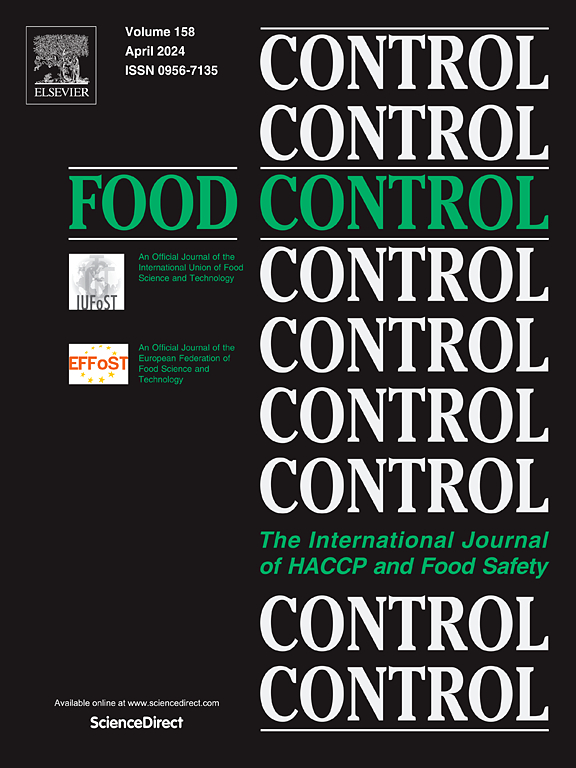Incorporation of whey protein with aqueous clove (Syzygium aromaticum L.) extract (nanoliposome and free forms) as an edible coating to prevent bacterial growth and oxidative spoilage of brown trout fillets
IF 5.6
1区 农林科学
Q1 FOOD SCIENCE & TECHNOLOGY
引用次数: 0
Abstract
The objective of this research was to assess the impact of whey protein coating with clove (Syzygium aromaticum L.) extract in free form (E) and nanoliposome (nano E) on changes (chemical, physical, microbial, and sensory) of brown trout (Salmo trutta) stored at 4 °C for 16 days. The physical results including PDI, particle size, EE% and zeta potential were in the range of 0.450–0.472 Mw/Mn, 74.43–110.54 nm, 49.63–64.24 % and −5.13 to −3.65 mV, respectively. The maximum and minimum of TPC, TVC and LAB counts were detected in control (8.4 for TPC, 7.4 for TVC, and 8.2 log cfu/g for LAB) and whey + nano E (7.3 for TPC, 5.8 for TVC, and 6 log cfu/g for LAB), respectively. The chemical results including PV, pH, TVB-N and TBARS were ranged from 11.9 (whey protein-nano E) to 19.8 meq/kg (control), from 6.6 (whey protein-nano E) to 7.7 (control), from 23.1 (whey protein-nano E) to 33.8 mg N/100 g (control) and from 4 (whey protein-nano E) to 7.35 mg MDA/kg (control), respectively. Lastly, in all sensory factors (discoloration, off-odor, red color and texture), the best consequence was associated to whey protein-nano E (score = 1). To conclude, it can be stated coating (edible) with whey protein-nanoliposome extract can be efficient in maintaining of brown trout quality.
乳清蛋白与丁香(Syzygium aromaticum L.)水提取物(纳米脂体和游离形式)的结合作为可食用涂层,以防止细菌生长和氧化变质的褐鳟鱼片
本研究旨在评估丁香(Syzygium aromaticum L.)游离提取物(E)和纳米脂质体(nano E)包衣乳清蛋白对褐鳟(Salmo trutta)在4°C保存16天的化学、物理、微生物和感官变化的影响。PDI、粒径、EE%和zeta电位分别在0.450 ~ 0.472 Mw/Mn、74.43 ~ 110.54 nm、49.63 ~ 64.24%和- 5.13 ~ - 3.65 mV范围内。对照组TPC、TVC和LAB的最大值和最小值分别为(TPC为8.4、TVC为7.4、LAB为8.2 log cfu/g)和乳清+纳米E (TPC为7.3、TVC为5.8、LAB为6 log cfu/g)。化学指标PV、pH、TVB-N和TBARS分别为11.9(乳清蛋白-纳米E) ~ 19.8 meq/kg(对照组)、6.6(乳清蛋白-纳米E) ~ 7.7(对照组)、23.1(乳清蛋白-纳米E) ~ 33.8 mg N/100 g(对照组)和4(乳清蛋白-纳米E) ~ 7.35 mg MDA/kg(对照组)。最后,在所有感官因素(变色、异味、红色和质地)中,乳清蛋白-纳米脂质体的效果最好(得分= 1)。综上所述,乳清蛋白-纳米脂质体提取物包被(可食用)可以有效地保持褐鳟的品质。
本文章由计算机程序翻译,如有差异,请以英文原文为准。
求助全文
约1分钟内获得全文
求助全文
来源期刊

Food Control
工程技术-食品科技
CiteScore
12.20
自引率
6.70%
发文量
758
审稿时长
33 days
期刊介绍:
Food Control is an international journal that provides essential information for those involved in food safety and process control.
Food Control covers the below areas that relate to food process control or to food safety of human foods:
• Microbial food safety and antimicrobial systems
• Mycotoxins
• Hazard analysis, HACCP and food safety objectives
• Risk assessment, including microbial and chemical hazards
• Quality assurance
• Good manufacturing practices
• Food process systems design and control
• Food Packaging technology and materials in contact with foods
• Rapid methods of analysis and detection, including sensor technology
• Codes of practice, legislation and international harmonization
• Consumer issues
• Education, training and research needs.
The scope of Food Control is comprehensive and includes original research papers, authoritative reviews, short communications, comment articles that report on new developments in food control, and position papers.
 求助内容:
求助内容: 应助结果提醒方式:
应助结果提醒方式:


